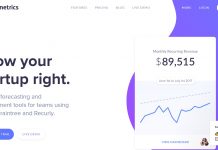Baremetrics: The Complete Guide to Smarter Subscription Analytics and Growth
In the modern digital economy, data is not merely a byproduct of business operations; it has become the foundation of growth, decision-making, and sustainability. For startups and subscription-based companies, understanding customer behavior, recurring revenue patterns, and long-term performance indicators can determine the difference between steady expansion and stagnation. Baremetrics, as one of the most comprehensive subscription analytics platforms, enables businesses to access, visualize, and interpret financial and behavioral data with precision.
This guide explores Baremetrics in 2025, its relevance, functionalities, and strategic applications for startups and established SaaS companies. The objective is to offer an in-depth understanding of how Baremetrics can enhance growth forecasting, customer retention, and revenue optimization while integrating seamlessly with modern payment processors and business ecosystems.
Understanding the Core Concept of Baremetrics
Baremetrics is a subscription analytics platform designed primarily for SaaS and subscription-driven companies. It connects directly with payment gateways and data sources to collect financial and behavioral metrics. These insights help teams understand monthly recurring revenue (MRR), customer lifetime value (LTV), churn rates, trial conversions, and cash flow projections.
The philosophy behind Baremetrics centers on transparency and clarity. Instead of relying on manual spreadsheets or fragmented reports, businesses can access real-time dashboards that update automatically as transactions occur. This automation not only minimizes human error but also allows decision-makers to focus on strategic actions rather than data preparation.
Baremetrics currently integrates with major payment processors such as Stripe, Braintree, Recurly, and Chargebee. These integrations allow companies to centralize their data within a single analytical environment, eliminating the need for complex data exports or additional development resources.
Evolution and Modern Relevance in 2025
In 2025, Baremetrics continues to evolve beyond simple analytics. It now functions as a complete growth intelligence platform. While it began as a visualization tool for SaaS metrics, recent updates have introduced forecasting modules powered by machine learning, retention analytics for cohort evaluation, and automated anomaly detection that alerts teams to unusual revenue or churn patterns.
The shift toward automation and predictive analysis reflects the broader industry trend where analytics platforms do more than describe what has happened; they provide insights into what will happen next. Baremetrics uses historical and behavioral data to project future outcomes, allowing startups to adjust pricing strategies, plan cash flow, and anticipate market behavior with higher accuracy.
For founders and data teams looking for reliable analytics solutions, exploring tools listed in tools can provide additional context on comparable services. However, Baremetrics distinguishes itself through its precision, ease of integration, and user-centered design.
Key Functionalities of Baremetrics
Baremetrics offers a collection of analytical and operational tools designed to address every stage of subscription management. The core features include:
-
Metrics Dashboard: A unified view of all essential business KPIs such as MRR, ARR, LTV, ARPU, and churn rate. Users can segment data by customer cohorts, acquisition channels, or subscription plans.
-
Forecasting Engine: Predicts future revenue and cash flow scenarios based on current performance and market conditions.
-
Customer Segmentation: Helps businesses group users based on behavioral and transactional attributes, enabling more precise marketing and retention strategies.
-
Trial Insights: Identifies which trial users are most likely to convert, allowing for targeted follow-ups.
-
Revenue Recovery Tools: Automates communication with customers whose payments fail, significantly reducing involuntary churn.
-
Benchmarks: Provides industry-specific metrics that let companies compare their performance with peers in similar markets.
-
Engagement Insights: Measures user activity and payment frequency to help identify signs of disengagement before churn occurs.
These features together form a holistic ecosystem that ensures businesses can measure, analyze, and act upon critical data in real time.
Integrations and Data Infrastructure
A key strength of Baremetrics is its integration ecosystem. The platform’s compatibility with major payment gateways, CRMs, and marketing tools ensures seamless data synchronization. It allows startups to connect their operational systems with minimal technical setup.
Recent updates in 2025 include improved API endpoints, enabling deeper customization and integration into proprietary business applications. For data engineers, the API provides access to structured metrics, allowing them to build custom dashboards or internal reporting systems without redundant data handling.
Moreover, Baremetrics supports secure data encryption and compliance with global privacy standards such as GDPR and CCPA. This commitment to data protection is crucial for SaaS platforms managing sensitive financial information.
Forecasting and Predictive Analytics
Forecasting in Baremetrics goes beyond simple linear projections. Its predictive engine leverages machine learning models that analyze historical revenue trends, churn behavior, and customer lifetime value. This allows the system to simulate future growth scenarios, helping businesses allocate resources more efficiently.
For example, if a SaaS company notices declining customer retention over a specific quarter, Baremetrics can identify cohorts or user segments contributing most to churn. It can also simulate how pricing adjustments or marketing interventions would affect future MRR.
These insights transform forecasting from a static estimate into an actionable decision-support process. Decision-makers no longer rely solely on intuition; they can test assumptions with empirical data before implementing strategic changes.
Customer Retention and Churn Management
Customer retention remains one of the most critical success factors for subscription-based businesses. Baremetrics provides detailed churn analysis that distinguishes between voluntary and involuntary churn. Voluntary churn refers to customers who intentionally cancel their subscriptions, whereas involuntary churn often results from failed payments or billing issues.
Baremetrics’ recovery tools automatically engage customers when payments fail, sending personalized notifications that encourage them to update their payment information. This proactive approach can recover a significant portion of lost revenue without manual follow-up.
Additionally, the cohort analysis tool visualizes retention trends across different customer segments. By examining how long users remain subscribed and which plans perform best, companies can identify patterns that inform both pricing strategy and product development.
Practical Applications for Startups
For startups, the utility of Baremetrics lies in its ability to simplify complex financial analytics. New companies often lack dedicated data teams, and manual data processing can consume valuable time. Baremetrics provides immediate insights without the need for SQL queries or advanced technical skills.
It also allows founders to present clear data visualizations to investors, demonstrating growth potential with transparent metrics. Many venture capitalists prefer companies that use standardized analytics tools since they provide consistent and verifiable data.
Startups using Baremetrics can focus on experimentation. They can test new pricing tiers, promotional strategies, or marketing funnels and immediately observe their impact on revenue metrics. This agility helps them stay competitive in rapidly changing markets.
Competitive Positioning
In the broader analytics ecosystem, Baremetrics competes with tools such as ChartMogul, ProfitWell, and SaaSOptics. Each of these platforms has its strengths, but Baremetrics stands out for its intuitive interface and balanced combination of automation and analytical depth.
While ProfitWell focuses heavily on pricing intelligence, and ChartMogul emphasizes data consolidation, Baremetrics offers a more balanced approach. It covers forecasting, engagement tracking, benchmarking, and recovery in one unified interface. This makes it especially appealing to small and medium-sized businesses that require comprehensive functionality without the complexity of enterprise software.
Moreover, the consistent updates released by Baremetrics ensure it remains relevant amid evolving SaaS industry demands. Its commitment to improving user experience and analytical accuracy has positioned it as a trusted choice among modern subscription businesses.
Advanced Usage and Implementation of Baremetrics
Setting Up Baremetrics for the First Time
For new users, onboarding Baremetrics is intentionally straightforward. The platform has been designed to minimize technical friction while ensuring the accuracy of integrated data sources. The setup process begins by connecting a payment processor such as Stripe or Braintree. Once connected, Baremetrics automatically imports historical and real-time transaction data into its analytical environment.
After importing data, users can customize their dashboards. Baremetrics allows flexible configuration of visual layouts, letting users prioritize key metrics such as MRR, churn, and LTV based on strategic focus. The dashboard updates dynamically, reflecting every new transaction or cancellation without additional manual refresh.
A fundamental advantage of this system lies in its instant accessibility. Startups can begin deriving insights within minutes of setup, avoiding the lengthy configuration processes that often accompany enterprise-grade analytics tools. This simplicity ensures that even small teams without data analysts can gain a deep understanding of their financial performance.
Data Visualization and Interpretation
Baremetrics transforms raw transactional data into digestible visualizations. It provides line charts, cohort graphs, funnel diagrams, and breakdown tables that make it easier to identify patterns across time. Visual clarity is one of Baremetrics’ most distinctive strengths because it supports comprehension across non-technical stakeholders such as founders, marketers, and investors.
Interpreting these visuals correctly, however, requires a solid grasp of key subscription metrics. Monthly recurring revenue (MRR) represents the predictable revenue generated from active subscriptions each month. Annual recurring revenue (ARR) scales this figure across twelve months, providing a longer-term perspective.
Churn rate quantifies the percentage of customers who cancel their subscriptions over a specific period, while LTV measures the total revenue expected from a customer throughout their lifecycle. When combined, these metrics reveal the health and sustainability of a company’s subscription model.
Through Baremetrics, users can apply filters to isolate metrics by acquisition channel, region, or pricing plan. This segmentation capability allows companies to determine which factors contribute most to retention or attrition, forming the foundation of evidence-based strategy.
Building Predictive Models and Growth Strategies
The integration of machine learning models into Baremetrics has turned predictive analytics into a central component of modern subscription management. Predictive features rely on continuous data learning. By examining customer cohorts and previous behaviors, Baremetrics can anticipate potential churn or forecast the impact of pricing experiments before implementation.
For example, if a business is considering increasing its monthly subscription cost, Baremetrics can model how this change might influence revenue and customer retention. These projections can prevent costly mistakes by allowing founders to simulate outcomes and assess risk levels ahead of real-world execution.
This capacity for predictive insight transforms Baremetrics from a passive reporting system into a strategic advisor. It empowers decision-makers to anticipate future scenarios and prepare adaptive strategies rather than reacting to historical events.
Reporting and Communication Efficiency
Another critical feature is Baremetrics’ ability to simplify financial reporting. Founders often need to communicate performance metrics to investors, partners, or internal stakeholders. Generating accurate and professional reports manually can be time-consuming. Baremetrics provides automated report generation, complete with visual summaries and annotations.
Reports can be exported as PDFs or shared via secure online links. The collaborative nature of the platform ensures that team members can view the same datasets without duplication. Access permissions can be configured to ensure data confidentiality while enabling transparent communication across departments.
These features make Baremetrics an effective bridge between analytics and leadership. Instead of spending hours preparing presentation data, teams can focus on interpreting insights and executing data-informed strategies.
Comparing Baremetrics with Alternative Tools
In 2025, the analytics landscape for SaaS businesses is crowded with solutions offering overlapping functionalities. Baremetrics differentiates itself through usability and comprehensive scope. ChartMogul and ProfitWell, for instance, cater to specific analytical niches, but Baremetrics balances breadth and simplicity.
ChartMogul provides powerful data normalization for companies managing multiple billing systems, while ProfitWell focuses on behavioral pricing intelligence and retention tools. Baremetrics, on the other hand, offers all core analytical and operational modules under a unified interface.
This unification reduces the learning curve and the cost of managing multiple tools simultaneously. For startups seeking scalability without excessive software dependency, Baremetrics serves as a sustainable long-term solution.
Still, organizations with complex enterprise structures might integrate Baremetrics alongside other systems. The API flexibility supports hybrid use cases, allowing data to flow seamlessly between internal databases, visualization platforms, and third-party CRMs.
Benefits of Using Baremetrics
The advantages of implementing Baremetrics are multifaceted:
• Time efficiency: automated data synchronization eliminates manual report generation.
• Accuracy: real-time updates minimize the risk of outdated or inconsistent financial information.
• Decision intelligence: actionable insights help founders make evidence-based strategic decisions.
• Transparency: team members and investors can access the same verified data sources.
• Scalability: the system grows alongside the company, supporting expanding user bases and transaction volumes.
• Predictive foresight: built-in forecasting and churn prediction tools empower proactive management.
These benefits collectively contribute to operational agility. In fast-moving markets where timing and adaptability are vital, the ability to access immediate and reliable analytics can determine long-term success.
Limitations and Considerations
Although Baremetrics offers extensive functionality, it is essential to recognize certain limitations. For businesses operating outside the subscription economy, its utility diminishes since most metrics are designed for recurring revenue models.
Additionally, while the platform’s automation simplifies use, it can occasionally limit customization for advanced data scientists who prefer raw data manipulation. In such cases, exporting data through the API and processing it in external tools like Python or R may be necessary.
Cost considerations also matter. While Baremetrics remains competitively priced compared with enterprise analytics software, startups with minimal revenue must evaluate whether the cost aligns with their financial stage. The value emerges most clearly when recurring revenue exceeds a few thousand dollars per month, justifying the investment in detailed analytics.
Best Practices for Maximizing Baremetrics Value
To fully benefit from Baremetrics, organizations should follow structured analytical practices. First, ensure consistent data hygiene by keeping payment systems synchronized and customer profiles updated. This prevents reporting discrepancies.
Second, establish periodic performance reviews using Baremetrics dashboards. Weekly or monthly reviews allow teams to detect emerging trends early. If churn begins to rise, immediate interventions such as personalized engagement campaigns can mitigate revenue loss.
Third, integrate Baremetrics into broader strategic planning. The forecasting tool can assist financial teams in budget allocation, while the engagement metrics can inform marketing campaigns. Embedding analytics into operational workflows ensures that decisions are always guided by current data rather than assumptions.
Finally, leverage cohort analysis to refine retention strategies. Comparing user cohorts based on acquisition channel or subscription age helps identify which segments respond best to promotions, upgrades, or feature releases.
Educational Value for Data-Driven Culture
Beyond operational utility, Baremetrics supports the development of a data-driven culture within organizations. By democratizing access to analytics, it encourages non-technical team members to engage with data meaningfully. Product teams can interpret feedback through metrics, marketers can validate campaign outcomes, and finance teams can assess ROI without external dependencies.
As businesses mature, this culture of analytical awareness becomes a strategic asset. Data literacy ensures that every team contributes to growth through informed decision-making. Baremetrics acts as the foundational tool enabling this shift toward organizational intelligence.
The Future of Baremetrics and Analytics in 2025
The year 2025 marks an inflection point for data analytics platforms. With the increasing use of artificial intelligence and automation, tools like Baremetrics are transitioning from passive dashboards into active business companions. The integration of AI-driven forecasting, automated alerts, and adaptive reporting suggests that analytics will soon be more predictive than descriptive.
Baremetrics’ roadmap reflects this direction, with ongoing improvements in anomaly detection, predictive revenue modeling, and user retention forecasting. Its ability to integrate directly with emerging payment solutions and low-code platforms ensures long-term compatibility with evolving digital ecosystems.
For modern startups, adopting such technology early provides a competitive edge. The faster a company establishes structured analytics, the quicker it can respond to market fluctuations and customer behavior changes. Baremetrics facilitates this readiness by merging simplicity with sophistication.
Strategic Applications in Startup Ecosystems
Within startup ecosystems, Baremetrics serves as both an educational and operational instrument. Accelerators, incubators, and venture capital networks often encourage their portfolio companies to implement standardized analytics tools. Baremetrics enables founders to track financial health transparently, providing stakeholders with confidence in reported metrics.
Moreover, community sharing through aggregated benchmarks allows emerging startups to compare performance anonymously with industry peers. This benchmarking promotes continuous improvement and fosters an environment of shared learning and competition.
Startups can also use Baremetrics to plan sustainable growth. Instead of relying on one-time spikes in revenue, they can identify consistent streams of recurring income and optimize pricing to maintain profitability. The platform’s forecasting functions help avoid overextension, ensuring that expansion aligns with realistic revenue expectations.
Integrating Baremetrics with Broader Business Tools
Baremetrics does not operate in isolation. Its flexibility enables seamless integration with complementary tools such as CRMs, marketing automation platforms, and customer success systems. When connected through APIs, the result is a unified data environment where marketing, sales, and product development share consistent insights.
For example, integrating Baremetrics with a CRM allows the sales team to monitor customer lifetime value directly within their workflow. Marketing teams can correlate campaign data with actual revenue outcomes, improving ROI assessments. Product managers can observe feature adoption rates and correlate them with subscription renewals.
This interconnected ecosystem transforms Baremetrics into a hub of operational intelligence. It becomes the backbone of coordinated decision-making across departments, ensuring that all teams align with measurable business goals.
Final Conclusion
In the contemporary landscape of data-driven entrepreneurship, Baremetrics represents a cornerstone for subscription analytics and business intelligence. Its evolution into a predictive, automated, and user-centric platform has redefined how startups and SaaS organizations interpret and act upon their data.
By consolidating critical metrics such as MRR, LTV, churn, and forecasting under one intuitive interface, Baremetrics eliminates analytical fragmentation. It empowers businesses to identify growth opportunities, anticipate challenges, and make informed decisions with speed and accuracy.
While no single tool can replace strategic thinking, Baremetrics provides the clarity and precision necessary for such thinking to be effective. Its commitment to continuous improvement and seamless integration ensures that it remains one of the most reliable resources for understanding subscription economics in 2025 and beyond.
For startups striving to transform raw data into strategic action, Baremetrics stands not merely as a tool but as an essential component of sustainable digital growth.










































